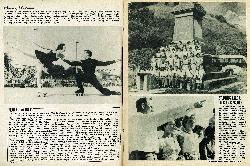2
Read all About it
We are often asked this question: "How is Photo News produced?" To give an answer in simple, non-technical terms which still convey the essentials of our process may not be easy, but the story goes something like this:
First of all, "Photo News" is entirely produced at 284 Aberdeen Road, where the initial step is to develop and proof the films taken on our cameras. From these proofs, pictures are selected for publication, and enlargements made. The selected pictures are then grouped into pages, and the captions are typed. The next stage is to re-photograph the pictures in a camera about six feet long, called a process camera, which converts the tones of the photographs into dots of various sizes, as a magnifying glass will show if applied to the picture on this page. The negative made in the process camera is then printed by photographic means on a sensitised metal plate. This metal plate (paper-thin aluminum) is clamped into the printing press which, at the rate of about 4000 copies per hour, prints an image on to a rubber-covered cylinder, which in turn prints on to the paper you are now holding in your hand. The plate is perfectly flat, and inking is achieved by rollers carrying a mixture of ink (grease) and a chemical fluid (water). As grease and water will not mix, only those portions of the plate on which the image appears are inked, while the non-printing portions of the plate absorb the water and repel the ink. This printing process is called lithography, or litho (pronounced lithe-o).
Any wiser, folks? The net result, as far as you and we are concerned, is that even after our photographs have gone right through the technical mangle described above, they still look like photographs when they reach you. Our constant aim is to have them look as good as the originals and now and again we even imagine they look a little better, which might suggest that at long last we are starting to turn out the kind of magazine we have been working and experimenting for.



